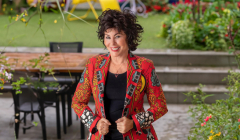
‘Being frazzled in the workplace has been dangerously normalised’
Comedian and actress Ruby Wax, Founder of mental health charity Frazzled, on taking stress seriously.

Olivia Stancombe, Senior strategist, Forever Beta explains why brands need to move beyond short-term badging exercises to better represent and reflect the queer community.

Last year the tragic murder of Geroge Floyd meant that many brands had to re-work, re-eveluate or re-create from scratch their annual (I use this word quite deliberately) campiagns in support of June’s Pride celebration.
The media spotlight on the BLM movement, as well as the countless blind spots and systemic injustices that the pandemic underlined, meant that it felt like intersectionality might finally be getting the mainstream consideration it deserves. It felt like we might finally face up to and embrace the complex nature of issues of sexuality or race (or any other community) rather than continuing to silo them into ‘neater’ more manageable topics to be tackled independently.
Then “It’s a Sin” hit in January this year, well outside the cultural calendar slot typically reserved for queer issues. It smashed viewing records and proved that these stories are not niche. Queer content had landed firmly in the mainstream, and although the show itself was utterly heartbreaking, I was thrilled by the reception it got and so thoroughly deserved.
And while it did make me reflect yet again on how rarely queer stories are front and centre (something that, as a gay woman, I felt a Saturday Night Live skit featuring Carey Mulligan titled ‘Lesbian Period Drama’ skewered upsettingly accurately), these factors also filled me with a new confidence that maybe 2021 would see a change to the usual Pride drill.
That, maybe this year, we’d see something new. Campaigns aimed at the queer community outside of the calendar appointment of June. Maybe a brand would start a multi-layered multi-platform, multi-community - dare I say it, intersectional - campaign in January that culminated in June and worked closely with the communities it was trying to represent. You know, something more than a seasonal activation or a quick hit “chuck a rainbow on it for pride” badging exercise.
There has been some brilliant Pride advertising in the past and there will be more this year but in 2021, after everything we’ve all been through, I just think we could all be doing so much more.
Olivia Stancombe, Senior strategist, Forever Beta
And yet, I can’t say I’ve noticed much of a change. Although I was encouraged to see that my local Sainsbury’s Pride bunting features the Progress Pride flag this year, which I will cling to as a small win.
At this point I'd like to point out that the above pessimism, while based on years of experience, is over-played somewhat to make a point. There has been some brilliant Pride advertising in the past and there will be more this year but in 2021, after everything we’ve all been through, I just think we could all be doing so much more.
There is still a feeling in the queer community (and many other communities for that matter) that advertisers and brands, rather than trying to talk to or support them, are actually just exploiting them for sales, or as a shortcut to cultural relavance.
So, I want to put forward a short set of simple actions that I believe could help us to move beyond this.
I'm sure I’ve written this before. And I'm even more sure you’ve read this before. But still it doesn't seem to be sticking so I thought best start with this again. Inclusivity will not work if it's a bolt on. It needs to be a strategic brand imperative and the reason you’re marketing in the first place.
2. Seek out different stories, experiences and perspectives.
People love a story. It’s in our DNA and our shared history - stories transcend issues such as gender or race or sexuality. This is why It’s a Sin worked so well. So get curious and start seeking out these stories for yourself. This can be as simple as following a queer activist or media outlet on Instagram (Munroe Bergdorf, Gay Times, Them and many more), reading a book (I’d highly recommend Torrey Peters recent novel ‘Detransition, Baby’, but there are countless lists of best queer fiction and non-fiction out there) or even watching something on Netflix (from documentaries like Disclosure, to Pose or Tales of the City or even Rupaul’s Drag Race).
3. Don’t use a community for their audience.
Don’t leverage a community’s identity or experience to make a brand seem more ‘woke’. Share a platform, let them use it to tell a story about themselves, rather than simply borrowing the useful ‘badge’ they carry. This is quickly becoming the new golden rule because getting this wrong is leading to a basic lack of trust in brands from those communities, who are beginning to feel used.
4. Then actually consult with them
This will stop you making mistakes that further drive that mistrust. Don’t assume you can speak on their behalf. Get out of the office (or living room) and start talking to people in the communities you want to engage with.
5. And one final point, you should all listen to BITE’s podcast Uncomfortable Conversations which is your tool kit for making sure you can do all of the above.
Olivia is a Strategist and Futurist who arrived at advertising via the worlds of design, luxury fashion and consumer trends consultancy. Named as one of Campaign's 'Faces to Watch: The Future of the Ad Industry 2017', she is an advocate for progress and an inclusive change in perspective in the industry. It is something she continues to drive the conversation on in her current role at Forever Beta.
Looks like you need to create a Creativebrief account to perform this action.
Create account Sign inLooks like you need to create a Creativebrief account to perform this action.
Create account Sign in